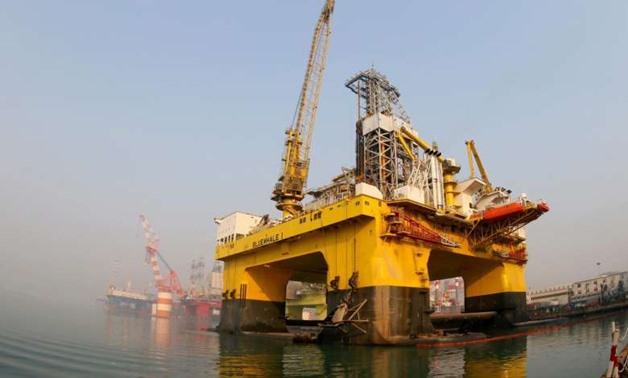
A semi-submersible drilling platform in the waters off Yantai, in China's Shandong province. PHOTO: AFP
Beijing - 2 July 2017:China is drilling deep into the ocean floor in the hope of tapping vast deposits of a frozen fossil fuel known as "combustible ice" but it will be years before it is part of the global energy mix.
Gas hydrates are found in the seabed as well as beneath permafrost but experts say extracting methane from the ice crystals is technologically challenging and expensive.
Energy-guzzling China, one of several countries hoping to exploit the hard-to-reach resource to meet growing demand, recently announced a "historic breakthrough" in drilling tests in the South China Sea.
In six weeks China extracted more than 235,000 cubic metres (8.3 million cubic feet) of gas hydrate off the coast of Guangdong province, according to a statement on the China Geological Survey's website.
"China has beaten expectations in completing the trial explorations of combustible ice using local innovations in technology and engineering," said Ye Jianliang, head of the Guangzhou Marine Geology Survey.
"It marks a historic breakthrough," he added.
One cubic metre of gas hydrate, which is also known as "flammable ice" because methane can ignite, releases 164 cubic metres of conventional natural gas once extracted, the US Department of Energy says.
Methane is extracted by heating or reducing the pressure inside the well to break down the hydrates.
Estimates for the size of the planet's gas hydrate deposits vary widely but the US department says it could exceed "the combined energy content of all other known fossil fuels".
Analysts say the substantial resource could be a "game changer" for countries that have limited access to conventional natural gas.
"The perfect example is Japan because they don't have much conventional gas and for them it could be an important reserve," said Ingo Pecher, a senior lecturer in the science faculty at New Zealand's University of Auckland.
Japan is heavily reliant on liquefied natural gas imports, with most of the country's fleet of nuclear reactors still offline more than six years after the 2011 tsunami disaster at Fukushima.
But Pecher said: "It boils down to economics."
While known and presumed gas hydrate deposits have been identified from New Zealand to Alaska, the challenge is to find ones that are highly concentrated and accessible.
Several countries are hoping to turn gas hydrate into a viable source of energy, including Japan which has reported drilling success off its Pacific coast.
The United States, which is also looking into the potential of gas hydrate, has obtained positive results from exploratory drilling in the Gulf of Mexico.
But commercially viable production is "another 10 years" away, said Paul Duerloo, partner and managing director at Boston Consulting Group in Tokyo.
"We know where the resource is, the technology we need to apply but the production rates out of the wells are not commercially sustainable at the current prices," said Duerloo, noting that shale gas, another unconventional energy source that faced similar challenges, took a long time to "take off".
China expects to start commercial production of gas hydrate "around 2030", according to the Ministry of Land and Resources.
Another concern surrounding gas hydrate extraction is the potential for methane -- a greenhouse gas -- to leak into the atmosphere and fuel global warming, said Xu Yuan, associate professor at the Chinese University of Hong Kong's geography and resource management department.
Nevertheless, gas hydrates have "huge potential" if the cost and technological hurdles can be overcome, he added.


Comments
Leave a Comment